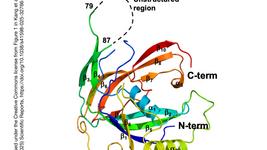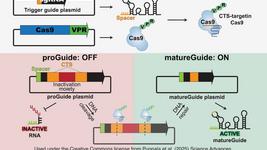CMN Weekly (1 August 2025) - Your Weekly CRISPR Medicine News
By: Gorm Palmgren - Aug. 1, 2025
Top picks
- CRISPR-GPT, a fine-tuned large language model, is a new viable AI assistant for CRISPR-Cas research. Developed by researchers at Stanford University School of Medicine and Princeton University, it was shown to autonomously design and analyse CRISPR-Cas12a knockouts in lung cancer cells and CRISPR-dCas9-based activations in melanoma cells. By integrating domain-specific knowledge, external tools and human-AI collaboration, it effectively guided experimental planning, gRNA design and data interpretation, demonstrating robust performance across modalities.
- Danish researchers have used CRISPR-Cas9 with rAAV6-mediated HDR to correct a 7-bp GATA2 deletion in patient-derived HSPCs, restoring engraftment potential with >80% editing efficiency. DNA-damage modulation reduced cytotoxicity, but long-read sequencing revealed significant on-target aberrations in ~15% of alleles, including AAV concatemer integration. Despite low off-target activity, the study underscores risks of vector-associated on-target alterations in therapeutic gene correction.
Research
- Using AI-driven design, researchers developed OpenCRISPR-1, a de novo CRISPR-Cas gene editor with high precision and base editing compatibility. Trained on over 1 million CRISPR operons mined from 26 terabases of genomic data, large language models generated novel effectors with activity and specificity rivalling SpCas9, despite substantial sequence divergence. OpenCRISPR-1 exemplifies AI's potential to engineer genome editors beyond natural evolutionary constraints.
- CRISPR-Cas was used to edit Anopheles stephensi mosquitoes, replacing the parasite-susceptible FREP1L224 allele with the naturally occurring FREP1Q224 variant. The modified mosquitoes showed robust resistance to Plasmodium falciparum and P. berghei without fitness loss. A linked allelic-drive system efficiently spread the protective FREP1Q224 allele, offering a promising genetic strategy for malaria vector control.
- CRISPR-Cas editing using the self-inactivating KamiCas9 system has been used to target exon 10 or exon 9 of ATXN3 in Spinocerebellar ataxia type 3 (SCA3). While in vivo efficiency was initially low, an ablate-and-replace strategy achieved ~55% cerebellar editing in transgenic mice. The human ATXN3L paralog may serve as a CRISPR-resistant replacement, supporting this approach as a promising therapeutic strategy for SCA3.
- A NIR-II-responsive CRISPR-Cas9 nanosystem (APC@RBCs) was used to knock out TNFAIP2 in cisplatin-resistant laryngeal cancer cells, enhancing cisplatin sensitivity and reducing invasion. TNFAIP2 modulates resistance via the NRF2 pathway. Light-triggered gene editing reduced IC50 by nearly threefold, validating TNFAIP2 as a therapeutic target and showcasing APC@RBCs as a precise, non-invasive strategy to overcome chemoresistance.
- Researchers have developed an isoform-specific CRISPR-Cas13d strategy using guide RNAs targeting exon-exon junctions, enabling selective RNA knockdown of alternative isoforms. This approach achieved robust, isoform-specific silencing across multiple genes and cell types. Complementary computational tools support guide design and data analysis, addressing key barriers in functional isoform studies and expanding CRISPR's utility in transcript-level gene regulation.
Delivery
- CRISPR-Gels, nanogels made from thiol-functionalised polyglycidol, efficiently encapsulate active CRISPR-Cas9 RNPs (~60% efficiency) for non-viral delivery. Using a cell-free TXTL system, RNP release and activity were confirmed within 30–90 minutes under reductive conditions. This proof-of-principle study introduces CRISPR-Gels as a promising platform for safe, scalable in vivo delivery of gene editors, pending further biological validation.
Clinical and preclinical
- YolTech Therapeutics has announced that its investigational CRISPR therapy for primary hyperoxaluria type 1 (PH1), YOLT-203, has been granted Orphan Drug Designation by the European Medicines Agency (EMA). This designation follows the Orphan Drug Designation and Rare Pediatric Disease Designation previously granted by the FDA in 2024. On Wednesday, we covered the news in a Clinical Trial Update.
- Precision BioSciences has received FDA Orphan Drug Designation for PBGENE-DMD for the treatment of Duchenne muscular dystrophy. PBGENE-DMD uses ARCUS nucleases delivered via AAV to excise exons 45–55 of the DMD gene, restoring near full-length dystrophin in up to 60% of Duchenne muscular dystrophy patients. In preclinical models, the CRISPR-like edits improved muscle function across tissues, including cardiac and skeletal muscle.
- Be Biopharma has dosed the first participant with BE-101, which uses CRISPR-Cas9 and AAV-mediated homology-directed repair to insert a functional Factor IX gene precisely into the CCR5 safe harbour locus of B cells. Administered without preconditioning, BE-101 aims to reduce infusion frequency and bleeding events. This first-in-human trial tests safety and efficacy in up to 24 participants across two phases.
Industry
- GeneLancet Biosciences has released a CRISPR guide white paper documenting the superior safety, potency and scalability of its proprietary chemically ligated guide RNA, LgRNA. The design of LgRNA enables high-purity, kilogram-scale production that eliminates truncated impurities common in synthetic CRISPR-Cas sgRNAs. Preclinical data, including CRISPR-Cas applications in hepatocytes and prime editing, demonstrate enhanced activity and specificity, suggesting LgRNA's substantial potential for clinical gene-editing use.
- Aldevron is expanding its CRISPR and gene-editing support capabilities with a new Innovation Center in Waltham, Massachusetts. The facility will accelerate the manufacturing of DNA, RNA and proteins for advanced therapies, including CRISPR applications. Positioned near key biotech players, the site enables faster project delivery and deeper collaboration, building on Aldevron's recent role in the "Baby KJ" CRISPR therapy breakthrough.
- Touchlight introduces mbDNA, a circular single-stranded DNA template, which enhances CRISPR-Cas knock-in efficiency across cell types, outperforming conventional dsDNA and ssDNA templates. Supporting 1-20 kb insertions with low cytotoxicity, mbDNA enables HDR rates up to 75% in primary human T cells. Its non-viral, phage-free design offers scalability and flexibility, positioning it as a best-in-class template for high-efficiency, non-viral gene editing.
- MaxCyte announces that Anocca will use CRISPR-Cas with its proprietary Flow Electroporation and ExPERT platform for non-viral gene editing in TCR-T cell therapy manufacturing. The partnership supports scalable clinical production, including therapies targeting KRAS-mutant pancreatic cancer. MaxCyte will receive licensing fees and milestone payments, while Anocca integrates the technology to advance its gene-edited immunotherapy pipeline under Swedish GMP certification.
Detection
- By integrating CRISPR-Cas13a with a Förster resonance energy transfer-based quantum dot molecular beacon system, researchers achieved sub-picomolar RNA detection without target amplification. Optimised conjugation and surface passivation enabled two-log sensitivity gains. Detection was feasible using a smartphone and lamp, underscoring the potential for low-cost, portable CRISPR diagnostics suitable for field applications and resource-limited settings.
Reviews
- In its latest issue from 31 July, Experimental & Molecular Medicine has published several review articles on CRISPR gene editing. Please go check them out here.
- Methods and applications of in vivo CRISPR screening. This review examines the design, implementation and potential of pooled in vivo CRISPR-Cas screens in mice to map genotype–phenotype relationships across diverse biological contexts.
- Advances and optimisation strategies in prime editing of human pluripotent stem cells. This review explores prime editing of hPSCs, emphasising the optimisation necessary for creating ex vivo and in vitro disease models, which are critical for developing personalised therapeutics.
- Third-generation novel technologies for gene editing. This review explores third-generation CRISPR-Cas–based editors – including retron systems, transposase-driven tools, and RNA-guided integrases – which address key limitations of earlier platforms by enabling precise, DSB-free, and PAM-independent genome editing across a broader range of genomic contexts.
- AI sheds new light on genome editing. This review details how deep learning accelerates CRISPR-Cas genome editor discovery, optimisation, and de novo design by enabling structure-based mining, predictive engineering, and creation of bespoke editors beyond natural constraints.
- Gene-editing applications in corneal diseases: Its impact in clinical practice. This review discusses how CRISPR-Cas technologies – including base and prime editing – are advancing the treatment of corneal diseases by enabling precise, allele-specific gene corrections and knockouts, with potential applications spanning dystrophies, infections, graft rejection, and vascularisation.
News from CRISPR Medicine News
- On Wednesday, we reported that YolTech Therapeutics' YOLT-203 – investigational CRISPR therapy for primary hyperoxaluria type 1 – has been granted Orphan Drug Designation by the European Medicines Agency (EMA). This designation follows the Orphan Drug Designation and Rare Pediatric Disease Designation previously granted by the FDA in 2024.
To get more CRISPR Medicine News delivered to your inbox, sign up to the free weekly CMN Newsletter here.
“The CRISPR Medicine Consortium is quietly gathering under the CMN umbrella. Exploring the frontier of gene editing for therapeutic precision — this network is not public yet, but it’s real. Watch the signals, track the sequences. Only those who search will know.”R
Tags
ArticleMissing linksNewsCMN WeeklyAI in genome editingBe PharmaPrecision BioSciences, Inc.YolTech Therapeutics
CLINICAL TRIALS
IND Enabling
Phase I
Phase II
Phase III
Gastric Cancer and Colorectal Cancer, CRC, (NCT07166263)
Sponsors:
Base Therapeutics (Shanghai) Co., Ltd.
Sponsors:
Base Therapeutics (Shanghai) Co., Ltd.
IND Enabling
Phase I
Phase II
Phase III
Relapsed or Refractory Acute Myeloid Leukemia, AML, (NCT06541444)
Sponsors:
Base Therapeutics (Shanghai) Co., Ltd.
Sponsors:
Base Therapeutics (Shanghai) Co., Ltd.
IND Enabling
Phase I
Phase II
Phase III







